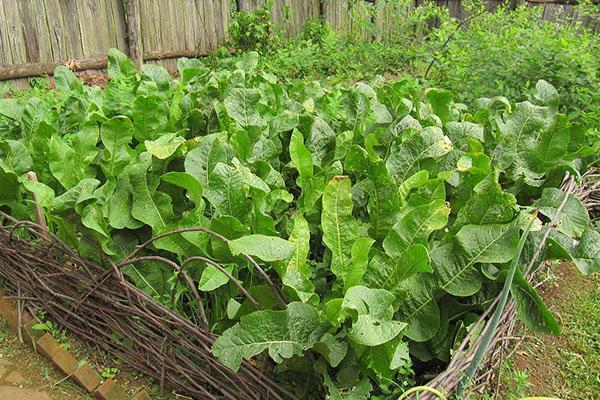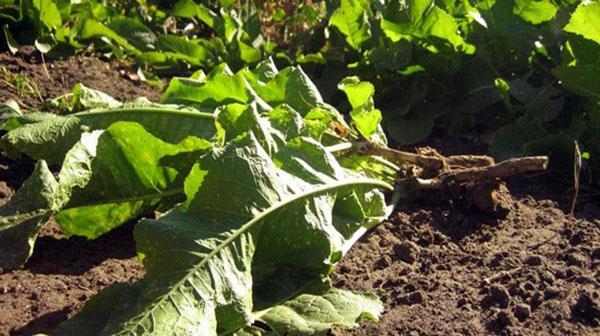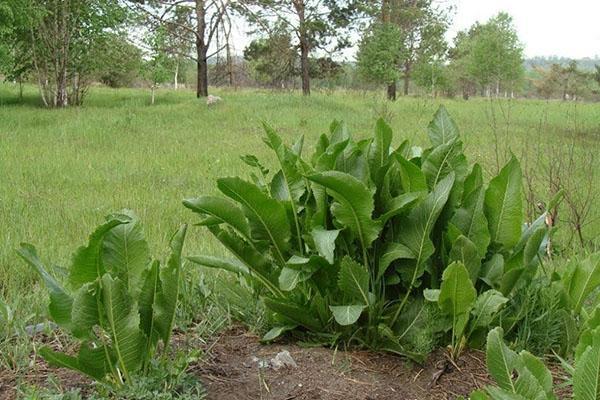Fascinating planting and horseradish care outdoors
 The spicy taste of the rhizomes of the perennial plant, as well as the spicy aroma that its leaves give, encourage many to grow horseradish in the garden. Timely planting and horseradish care will help the farmer reap a rich harvest. It is important to know when and how best to land in open ground.
The spicy taste of the rhizomes of the perennial plant, as well as the spicy aroma that its leaves give, encourage many to grow horseradish in the garden. Timely planting and horseradish care will help the farmer reap a rich harvest. It is important to know when and how best to land in open ground.
The culture can be propagated both by cuttings and by seeds. The second method is rarely used.
Planting and caring for horseradish according to the law of nature

Transplanting seedlings into the ground is successfully practiced as soon as the snow melts. Although the ground may still be cold, it will not harm the development of the rhizome.
Time and timing of planting horseradish
 A perennial plant is considered winter-hardy, since it tolerates fluctuations in night and day temperatures (even with a difference of 20 ° C). Its natural habitat is marshland, the shores of water bodies or areas of high humidity. Therefore, answering the question when horseradish is planted, it is safe to say - in late autumn or early spring. Some do it in late March or early April. However, 2 weeks before planting, they germinate seedlings:
A perennial plant is considered winter-hardy, since it tolerates fluctuations in night and day temperatures (even with a difference of 20 ° C). Its natural habitat is marshland, the shores of water bodies or areas of high humidity. Therefore, answering the question when horseradish is planted, it is safe to say - in late autumn or early spring. Some do it in late March or early April. However, 2 weeks before planting, they germinate seedlings:
- get the chopped roots out of wet sand (the box is stored in the basement);
- examine each of them;
- they are trimmed according to the principle: the upper cut is made even, and the lower cut obliquely, making the angle as sharp as possible;
- with the help of hard matter, filamentous processes are removed from the middle part of the cuttings, thereby "blinding" the buds so that the root does not branch much;
- then they are covered with a damp (well moistened) cloth or a thick layer of peat;
- leave in a warm place before planting horseradish in the spring.

Preparation of cuttings begins in the fall. In the garden, annual plants are chosen, the root thickness of which is about 1 cm.They are divided into segments about 20-30 cm long.
Autumn or summer season
 As soon as the cuttings germinate, they are transplanted to a garden bed, with conditions suitable for culture. However, before that, you need to figure out how to plant horseradish in the fall in order to get a harvest for the next year. Practice shows that it is better to do this in October or even November. There are several simple guidelines for this procedure:
As soon as the cuttings germinate, they are transplanted to a garden bed, with conditions suitable for culture. However, before that, you need to figure out how to plant horseradish in the fall in order to get a harvest for the next year. Practice shows that it is better to do this in October or even November. There are several simple guidelines for this procedure:
- plant cuttings in the place where tomatoes, beets used to grow, cucumbers or potatoes;
- remove all weeds, as well as the remnants of past crops;
- carefully dig up the site;
- place the roots much deeper than when planting horseradish in the summer.
When propagating a perennial plant in June, you should not expect the harvest to ripen by autumn. As in all other cases, the gardener will only collect the fleshy spice next season. Therefore, having determined the suitable dates and terms for yourself, you can start choosing a place.
 Not everyone knows how to plant horseradish seeds. If you can find seed, then it is better to act according to the instructions. Seeds collected on their own are sown before winter or early spring.
Not everyone knows how to plant horseradish seeds. If you can find seed, then it is better to act according to the instructions. Seeds collected on their own are sown before winter or early spring.
In the northern regions, grains do not have time to ripen over the summer, so this technology is often not relevant.
The right place for horseradish is an important nuance
 For culture, it is recommended to select well-lit areas or areas with weak penumbra. Some plant horseradish near the fence, as well as under trees that do not have a very dense crown. In thickets, a deciduous rosette will develop poorly. As already noted, representatives of the families can be the predecessors of a perennial:
For culture, it is recommended to select well-lit areas or areas with weak penumbra. Some plant horseradish near the fence, as well as under trees that do not have a very dense crown. In thickets, a deciduous rosette will develop poorly. As already noted, representatives of the families can be the predecessors of a perennial:
- nightshade (potatoes, tomatoes);

- cereals;
- pumpkin (cucumbers);
- legumes;
- amaranth (beets).
It is better, of course, that there is nothing in the garden before planting horseradish. Also, the cultivation of a root crop is not advisable in the beds where cabbage, mustard, radish or rutabaga used to grow.
First, the site is thoroughly plowed. The depth of digging is 30-35 cm. Be sure to add humus there, compost or other fertilizers. At the same time, some agronomists argue that after adding manure to the land, a perennial plant is planted only for 2 or 3 years.
Rules for the selection of soil for horseradish
 The ideal conditions for the growth of culture will be lands with a neutral or slightly acidic reaction. In such cases, loam, chernozem and sandy loam type of soil are suitable for him. At the same time, it is important to know exactly what kind of soil horseradish loves in order to get a high-quality harvest. There is only one secret - it must be fertile. Therefore, before spring planting in the fall, they bring in:
The ideal conditions for the growth of culture will be lands with a neutral or slightly acidic reaction. In such cases, loam, chernozem and sandy loam type of soil are suitable for him. At the same time, it is important to know exactly what kind of soil horseradish loves in order to get a high-quality harvest. There is only one secret - it must be fertile. Therefore, before spring planting in the fall, they bring in:
- humus;

- wood ash;
- nitrophosphate.
The garden bed is carefully dug up and then watered abundantly. If you have to plant a herbaceous plant on heavy clay soil, then a number of procedures must be carried out:
- In late autumn, add peat, manure and sand.
- Plow the area. The embedment depth is 30 cm.
- Fertilize the soil in early spring superphosphate (30 g / 1 m²), potassium salt (30 g) and ammonium nitrate (1 tablespoon).
Despite such a powerful feeding, do not expect supernatural results. Indeed, in such beds, planting and caring for horseradish is a rather painstaking task. As a result, the rhizome will not be as juicy / fleshy and bitter. However, it is still worth trying to do your best.
Horseradish planting technology
 Cuttings are harvested at harvest time - in autumn - and in some cases in March. The maximum diameter of the cuttings is 1.5 cm, and the length is 15-20 cm. The sprouted roots are planted in prepared soil. At the same time, the following technology is observed:
Cuttings are harvested at harvest time - in autumn - and in some cases in March. The maximum diameter of the cuttings is 1.5 cm, and the length is 15-20 cm. The sprouted roots are planted in prepared soil. At the same time, the following technology is observed:
- the interval between copies is 30 cm;
- row spacing - 60 or 70 cm;
- the hole is formed with a thick peg, piercing the soil at an angle of 30-45˚ with respect to the surface;
- a handle is placed in the hole, but only with an oblique cut;
- sprinkle the top with soil (layer thickness 3-4 cm);
- compact the landing area;
- watered with rainwater in several steps.
 In addition, short cuttings are placed in an upright position. It should be borne in mind that the plant grows a lot, so you don't need to worry about how to breed horseradish in the garden, he will do everything himself. Still, farmers build protective fences for it. Trenches are dug along the perimeter of the beds, and then metal plates or slate are installed in them.
In addition, short cuttings are placed in an upright position. It should be borne in mind that the plant grows a lot, so you don't need to worry about how to breed horseradish in the garden, he will do everything himself. Still, farmers build protective fences for it. Trenches are dug along the perimeter of the beds, and then metal plates or slate are installed in them.
Many gardeners advise not to bury the buds, but to leave them protruding from the ground by 2-3 cm. It is not known what caused this difference in technology. However, many textbooks provide a full-immersed sprout scheme.
Easy to grow horseradish
 The method of crop care depends on the relief features of the area. On flat areas, they do with the usual loosening of the soil, and the plants planted on the ridges have to huddle. When the first shoots appear, it is necessary to remove weak shoots, leaving only strong specimens. This is one of the important rules on how to grow horseradish in the country, so that it does not spread throughout the garden. The gardener will get an excellent harvest if he applies the basic rules of care:
The method of crop care depends on the relief features of the area. On flat areas, they do with the usual loosening of the soil, and the plants planted on the ridges have to huddle. When the first shoots appear, it is necessary to remove weak shoots, leaving only strong specimens. This is one of the important rules on how to grow horseradish in the country, so that it does not spread throughout the garden. The gardener will get an excellent harvest if he applies the basic rules of care:
- Loosening.Planted cuttings need oxygen, so the garden is weeded a week before germination. Then only the aisles are processed and weeds are removed in time.

- Top dressing. It has already been discussed above how to fertilize the soil. However, after 2-3 weeks the plant may develop very slowly. Then it is watered with a solution of mullein, prepared in a ratio of 1:10. If necessary, use potassium and nitrogen complexes, but only after the appearance of the first shoots.

- Watering. The culture is very hygrophilous, however, there is no need to flood it. For 1 m² it is enough to add 10-20 liters of water. Weather conditions play a leading role in how to care for horseradish. If it is poured, the rhizome will fester, and if it is overdried, it will become tough and sinewy.

In July, the planting is excavated and the lateral processes that have formed in the upper part of the taproot are cut off. After that, the culture is again poured, tamped and watered the site.
 The listed methods of planting and caring for horseradish cannot be called standard. Much will depend on the climatic conditions of a particular region. Therefore, every gardener must understand the basic principles of this process, as well as the characteristics of the culture itself.
The listed methods of planting and caring for horseradish cannot be called standard. Much will depend on the climatic conditions of a particular region. Therefore, every gardener must understand the basic principles of this process, as well as the characteristics of the culture itself.